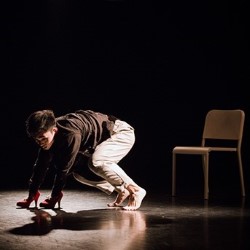Folding Echoes might be a response to some people’s questions about contemporary dance – what does it all mean? In the first few minutes, Joseph Lee bangs his head on a chair. Then he sticks it in the door! These simple moves tell of serious frustration, perhaps with the audience for asking this question, or perhaps with the more impenetrable aspects of the genre itself.
Born in Hong Kong and a trained accountant, Lee undertook a masters at the renowned London Contemporary Dance School (The Place) and has toured and won awards around the world. Lee manages that rare thing: to be serious and to poke fun at his subject in one show.
Many of the amusements are in the script. He starts by addressing the audience as if giving an after-performance talk about what he’d just done, but he also deconstructs movement phrases which mean ‘love’ and ‘hate’. Using ultra clear gesture he goes on to develop these moves, adeptly demonstrating how some choreographers initiate dance.
What follows is a duet with a chair and, later, a pair of shiny red stilettos: “Of course dance can address some contemporary problems or issues. One of them is gender” he says. We laugh again. This is clearly a reference to the macabre Hans Christian Anderson tale and film of the same name in which a vain girl is punished by shoes which never stop dancing, even when her feet are amputated.
Occassionally there is a hint of the ‘101 things to do with a prop’ exercise; and as with many choreographers presenting at the Festival this year, he uses extreme repetition, angst, manic shuddering, and painful falls as knees strike dance floor. However, he performs much of this with irony, and, cleverly, we don’t always know which side of that line he has stepped over.
When he suddenly rushes offstage through the emergency exit, leaving only a slant of bright behind him (he plays with light very effectively throughout the show), our attention is drawn to the paraphernalia of the theatre that we usually pretend isn’t there. And so we are left with interesting questions about the nature of performance, the art of making dance, the relationship between the audience and who we watch. We are in admiration, and we are smiling because he simultaneously achieves this and sends himself up: “bullshit, bullshit” he says.
